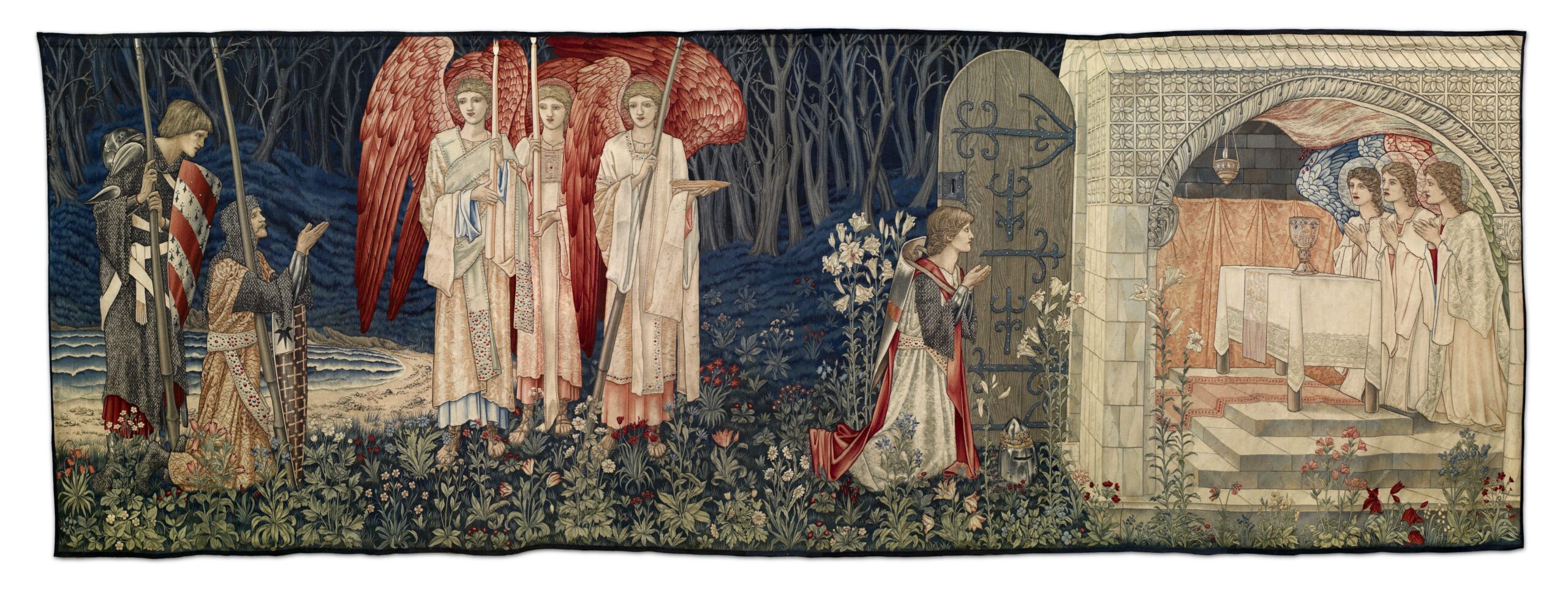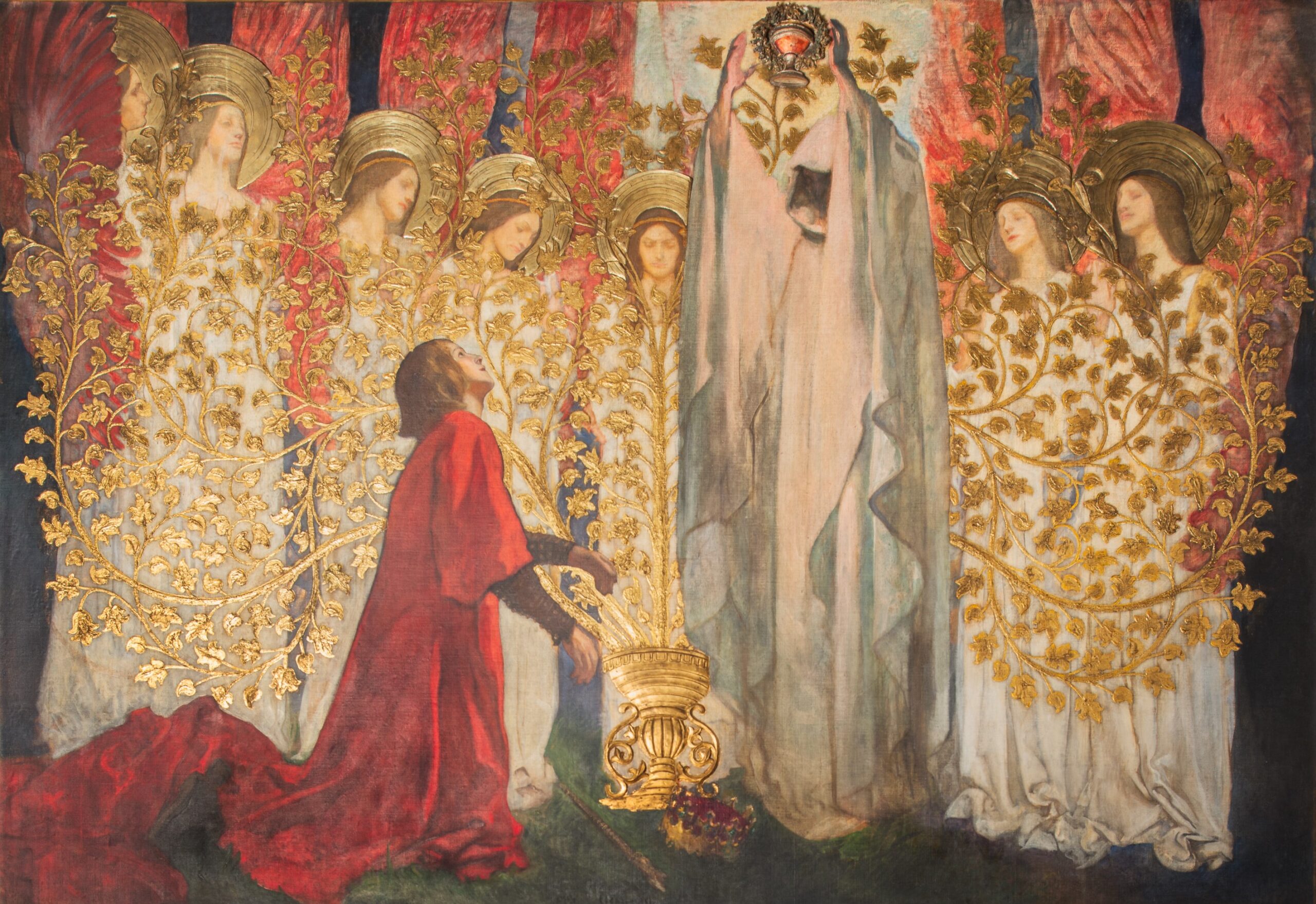|
Getting your Trinity Audio player ready...
|
Above: “The golden tree” was painted AD 1893-1902. The painting depicts the legendary Sir Galahad receiving the Holy Grail and ascending to heaven with it after building a golden tree. It is part of the “Abbey Room Murals: The Quest and Achievement of the Holy Grail” by by Edwin Austin Abbey (1852-1911).
“And Moses hid his face; for he was afraid to look upon God.” – Exodus 3:6
There is a regrettable tendency, no doubt encouraged by the frequency of rather soft and sentimental images of the Sacred Heart of Jesus, to see the devotion as a particularly feminine one. The truth is that veneration of Our Lord’s most Sacred Heart has long been the choice devotion of the Church’s knighthood; an icon of the Divine Love to which the knight offered himself and sought to live within, and deeply bound up with the cause for political Christianity, going back to the Crusades and beyond.
Leon Gautier famously defined Chivalry as “the Christian form of the military profession: the knight is the Christian soldier.” Precisely because the Germanic warrior ethos was Christianised, chivalry was more than a code of martial virtue. As Michael Warren Davis has pointed out, it became, so to speak, the “lay spirituality” of Medieval Europe.
For the founder of the Order of the Knights of Our Lady, Dom Gérard-Marie Lafond, “Like the flaming sword of the Angel at the entrance to Paradise, the sword of chivalry protects Christendom against the intrusions of the profane world. Chivalry is an inner temple and outer fortress.” Here is our key to the mystical dimension of chivalry. Within knightly piety the knight sought to conform his own ‘inner temple’ evermore closely to the inner temple of Our Lord’s Sacred Heart, the source of His love.
As René Guenon wrote, “The heart itself, the vase which contains the blood, is the centre of life and also the centre of the entire being.” It is therefore identifiable with the Holy Grail, the Chalice of the Most Precious Blood, the Holy Eucharist. Indeed, every Eucharistic miracle has seen the visible transformation of the accidents of the Host into heart tissue. Traditionally, the Holy Grail was believed to have held Our Lord’s Most Precious Blood for a second time after the Last Supper, when it was used by St Joseph of Arimathea to catch the blood and water which flowed from Our Lord’s Sacred Heart after it was pierced by the soldier, and later convert, Longinus. Following this first soldier saint, ‘The mystical tradition of chivalry has described the stages of the knightly conversion in the Quest of the Holy Grail, which is none other than the search for God Himself and for the Divine Wisdom concealed in the Heart of Christ’ (Dom Gérard-Marie Lafond).
The Queste del Saint Graal forms the central section of the thirteenth-century French romance triptych known as the Prose Lancelot, the biography of the greatest of Arthur’s secular knights, whose son Galahad (of the lineage of St Joseph of Arimathea), concludes the marvellous adventures of the Holy Grail. The cycle begins when the Holy Grail is seen in a spectacular vision at King Arthur’s Pentecostal court feast, and the knights of the Round Table embark on a quest to find it. Although on the surface the adventure consists of a series of conventional tests of chivalric prowess, the quest is also an allegory intended by the Cistercian monks – who were very likely its authors – to signify the interior journey of spiritual enlightenment.
In the tale, those knights that only dwell on the earthly significance of the various tests and of winning honour and glory invariably fail and experience the bitter fruits of death, while those knights who understand the spiritual significance of the tests, who embody the chivalric virtues of chastity, magnanimity, and righteousness, draw closer to the Grail mysteries. These truths are illumined by various hermits and white monks who appear throughout the story and explain the meaning of the visions, dreams and symbols of each adventure, giving the knights’ spiritual education. One hermit tells Lancelot that he will fail in his quest because of his adulterous relationship with Queen Guinevere, prompting his confession and resolution to live a life of ascesis and chastity, while Gawain’s pride causes him to fail to progress and to return to Arthur’s court. The virgin knight Galahad, however, along with Perceval and Bohort, attains the mystical vision of the Grail, where the crucified Christ rises from the Vessel and administers the Sacrament, before he dies in raptures of ecstasy.

As befitting its Cistercian origins, the Quest of the Holy Grail communicates meaning on multiple levels: the literal, the tropological or moral, and the allegorical. At the moral level Galahad is the exemplary Christian knight, his soul yearning for union with God in the figure of the bridegroom like the bride in the Song of Songs. In his celebrated sermons on the Song of Songs, the great Cistercian St Bernard of Clairvaux deepened the tradition of interpreting the Song in reference to the burning love between God and the human soul. Allegorically, Galahad (his name deriving from ‘Gilead’ in the Song – meaning ‘heap of testimony’) is a figure of Christ; his mission is to complete the Grail adventures and lead the way through the vicissitudes of life in a fallen world to the New Jerusalem.[1] Thus, like a gothic cathedral and Holy Scripture itself, the Quest of the Holy Grail has a fractality of correspondences between the microcosmic and the macrocosmic. Galahad’s Grail Quest “is a journey within Christianity from outward observance to the inner meaning of that observance, until heaven itself can be seen by the pure of heart, within the Chalice of the Holy Blood” (Stratford Caldecott).
When chivalry was born at the beginning of the High Middle Ages, the great Crusader and leader Godfrey of Bouillon (one of the Nine Worthies) took as his heraldic emblem the ‘Jerusalem Cross’ – one large cross with four smaller crosses at each side. These symbolised the Five Wounds, including the central wound in the side of Christ from where sprung the blood and water from His Sacred Heart. For the crusaders embarking on armed pilgrimage to the Holy Land, from where over a third would not return[2] and many more would be rendered scarred and crippled, the Five Wounds of Our Lord and the Passion He endured for our redemption took on a particularly immediate poignancy. The offering of one’s life on the battlefield for Christ and His Church was the ultimate ‘priestly’ action of the layman. “The good knight offered his immolation for the glorification of the Church, the spreading of the Faith, and the common good of the temporal sphere” (Plinio Corrêa de Oliveira). It is therefore supremely fitting that the Sacred Heart, the radiant manifestation of God’s love, should have a central place in the knights’ spirituality. “Greater love hath no man than this, that a man lay down his life for his friends.”
Like Sir Galahad, the Beloved Disciple St John is a virgin and pure of heart. Perhaps this is why he received the supreme privilege of the revelation of Our Lord’s Sacred Heart and the Divine Love within when he reclined at His side during the Last Supper. For those of us who are not always pure of heart like St John and Galahad, we have the example of St Thomas the Apostle, who abandoned Him at the hour of His Passion and then doubted His Resurrection, but was nevertheless invited to put his hand into his side and touch His Sacred Heart. His ecstatic words of confession, “My Lord and My God,” are those of all of us sinners who worship Our Lord at the consecration of the Blessed Sacrament. Here the Grail Quest finds its fulfilment!
Cor Jesu Sacratissimum misere nobis!
Sanguis Christi, in Eucharistia potus et lavacrum animarum, salva nos!
[1] Pratt, K. (1995). The Cistercians and the Queste del Saint Graal. Reading Medieval Studies, 69-96, p. 72.
[2] Riley-Smith, “Casualties and Knights on the First Crusade,” Crusades 1 (2002), p. 17-18.


